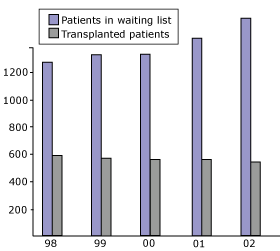Stages for the recipient of an organ transplantEvaluation of the patientDecision to treat by a transplantation is critical choice in which several aspects take place with the most important aim to offer a safe extension and a better quality of life to the patient. Before considering a transplantation, the patient undergo a complete medical history and physical examination (pre transplant work-up) to evaluate the risks and the outcomes. Classical examination includes : age, viral serology (hepatitis B and C viruses, HIV, CMV, Epstein-Barr virus), cardiovascular disease, gastrointestinal complications, infectious status, psychological examination. A few absolute contra-indications (uncontrolled cancer, HIV positivity, old age, ...) to all transplantation exists but most "illness" are generally relative contra-indications despite increasing the risk of post transplant morbidity and mortality and are considered case-by-case for each transplantation. If transplantation could be an option, the patient is placed on a waiting list.
Waiting for an organPatients considered for a transplantation are registered on the waiting
list of the national coordination center that takes an inventory of several
criteria (waiting time, blood and HLA compatibility, physical state, state
of illness, ...) of the potential recipient. Waiting list is essential
to match rapidly potential organ recipients with available organ donors. Unfortunately, number of transplant candidates increases, whereas supply of organ donors decrease. Waiting time has becoming an essential parameter to consider before a transplantation therapy. Each year, several patients still die in the waiting list due to organ shortage. Matching organ and policiesWhen a deceased organ donor is identified, the most suitable transplant candidate on the waiting list is selected by matching against the donor characteristics. Each organ has is own allocation system based on specific and precise criteria (recipient's age and health statue, organ size, blood and tissue compatibility, ...). When living donors are considered, selection is done upon the donor and problems coming from the preservation of the organ are less restrictive. |
|
|
Transplantation Immunology | |||||||||||||||||||
|
||||||||||||||||||||



 Print
Print